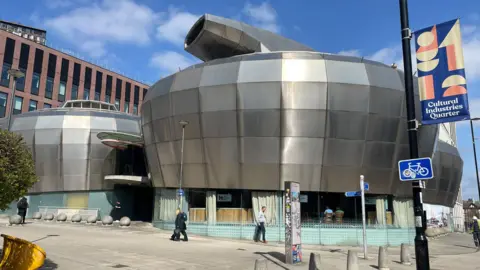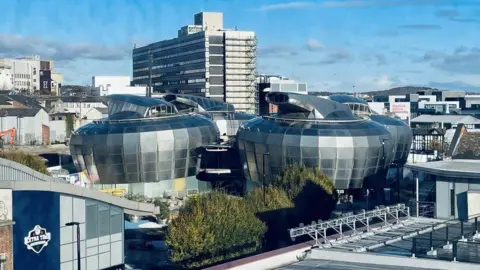The story of Sheffield's at-risk millennium building
 BBC/Elliott Green
BBC/Elliott GreenA former music museum labelled 'at risk' has been described as an "extremely unusual and distinctive piece of architecture" that represents the city of Sheffield.
The National Centre for Popular Music has most recently been used as Sheffield Hallam University's student union building, but was cited as "extremely vulnerable" following news the union was relocating.
The Twentieth Century Society included the landmark on its national list of buildings vulnerable to neglect, dereliction or demolition, but the university said it had no plans for demolition and was exploring alternative uses.
Construction work began on the four 'kettles' in 1997 and it opened in 1999 as a millennium project.
But the National Lottery-funded attraction closed 17 months later after it failed to attract enough visitors. In 2002 it was sold to Yorkshire Forward and a year later to the university.
 Phil Coomes/BBC
Phil Coomes/BBCHelen Jackson was chair of employment for economic development when the design process began, and Hillsborough MP when the museum opened.
She says the design was part of regeneration plans for the city, following a rise in unemployment rates caused by a decline in industry across South Yorkshire.
"It represents a period when Sheffield were doing some very unusual and, in a way, imaginative work to counter the dreadful situation for the city because of the closure of so many of the steel plants and ensuing unemployment," she says.
"We aimed to get industries going that were helpful and welcoming for young people in the city and we chose pop music because The Human League and other groups were very popular at that time."
The four 'kettles' were based on kettle drums and were covered in Sheffield steel to connect the design to the city's heritage.
"It didn't last that long but it was a symbol of Sheffield," says Jackson.
"It was not the thing that city councils do these days, they don't sadly have the imagination or cash to do this sort of thing, but we were proud of it and it was part of a regeneration package that was going to help alleviate unemployment."
The policy to encourage the music industry in the city also led to the creation of Red Tape Studios and The Showrooms – both of which remain today.
Jackson remembers a time when the plans for the venues were put forward to the city council's treasurer by none other than Sheffield band The Human League.
"I vividly remember a meeting about Red Tape Studios," she says.
"We had invited members of The Human League and they wandered in looking uncouncillor-like, in sandals, and joined us in trying to persuade the council treasurer who was a bit iffy about the whole thing.
"The treasurer said: 'I don't know about the money' and the band chipped in 'we can help with that', and so the ratepayers were saved."
 Dave Pickersgill/Geograph
Dave Pickersgill/GeographIn 1989, Simon Gedye, now chair of Sheffield Civic Trust, had just arrived in Sheffield and was working as an architect.
"There was very little investment in the city," he says.
"The city was struggling with design quality, so this was an important building at the time. It summed up a time of optimism and New Labour, the designer also worked on the Millennium Dome."
Mr Gedye created a team and submitted architectural plans for The National Centre for Popular Music, but after being shortlisted he lost out to Nigel Coates who won the commission and went on to create the 'kettles'.
"Nigel Coates was the most prominent gay architect of his generation," says Mr Gedye.
"He's an interesting architect and a lot of his work was fairly ephemeral. So there's not much of his built work left, so this is an important building of his and for the city.
"There was a lot of National Lottery funding so there was huge change.
"There was a number of projects in South Yorkshire - Magna, the Earth Centre - and this was one of them, and they were ambitious in terms of their design and quality and in terms of what they were trying to do."
'Amazing and jewel-like'
Today, from his perspective of chair of Sheffield Civic Trust, Mr Gedye says the "iconic" building is an "important part of our built heritage".
"We're in the business of promoting everything that's of quality in terms of architecture and public art in the city.
"We've been concerned about what was the National Centre of Popular Music building because it is iconic.
"It's an extremely unusual and distinctive piece of architecture. We've had a lot of discussion and concern that when Hallam University were moving their student union out it might be a risk to that building.
"There are a number of buildings of this age that are slightly under the age for listing by Historic England, which are changing and are at risk from not being protected."
The group has now put in a local listing application for the building in a bid to ensure its protection.
He says: "It's a very beautifully detailed piece of architecture. To some degree it has been obscured by its use as the student union because they've applied lots of film to the exterior of the building but it's a very clear and beautiful building internally.
"I've no doubt some people look at that building and say its ugly. It is stained at the moment but when it's cleaned and when you see the photographs of it new, it looked amazing and jewel-like."
Listen to highlights from South Yorkshire on BBC Sounds, catch up with the latest episode of Look North
